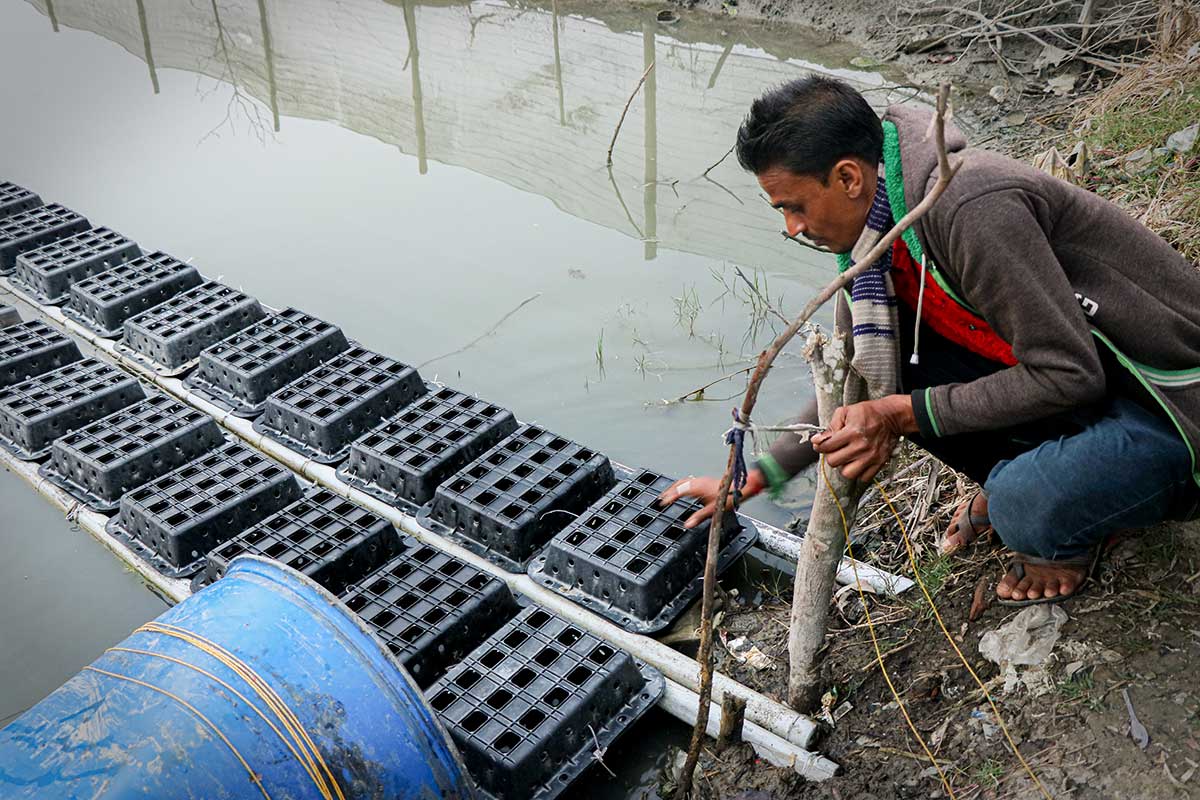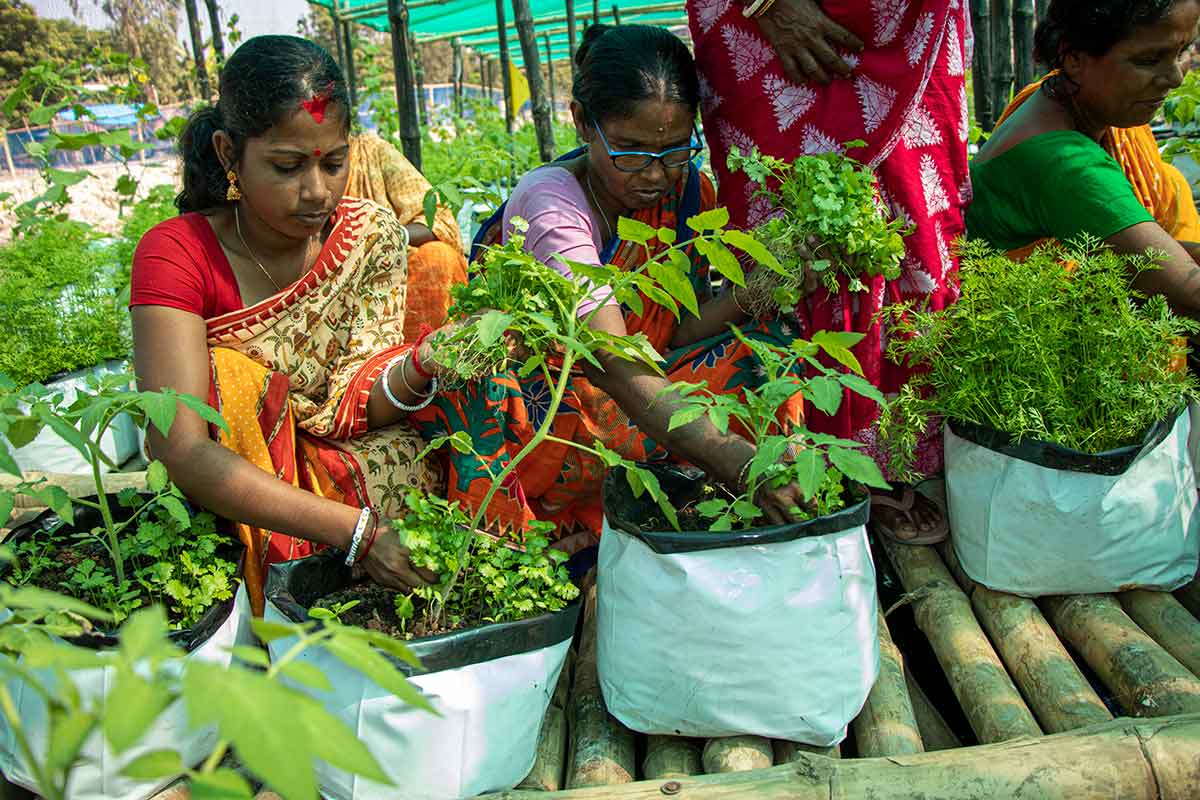Float farming in northeast India: Where tradition and technology come together to tackle climate change
Patient, predictable, accessible funding
Invest in local capabilities
Flexible programming and learning
Build understanding
Organization: South Asian Forum for Environment (SAFE)
In the face of intensifying cyclones and floods, farmers in Northeast India are turning to a centuries-old tradition—float farming—to secure their livelihoods and adapt to climate change. With rising sea levels and unpredictable weather patterns threatening agrarian communities, a pioneering initiative by the South Asian Forum for Environment (SAFE) is transforming traditional float farming techniques into a climate-resilient solution.
Float farming, inspired by ‘baor’, a traditional Bangladeshi wetland farming method, has been revived and enhanced through close collaboration between SAFE and local farming communities. Unlike top-down interventions, this initiative puts farmers at the helm, allowing them to participate in raft design, crop planning, budgeting, and resource management. A Local Project Monitoring and Review Committee ensures that governance, monitoring, and evaluation remain firmly in the hands of the community.
Innovative Floating Agriculture for Climate Adaptation
SAFE’s modernized approach to float farming uses bamboo rafts fitted with growbags filled with a recycled organic soil mix. To ensure sustainability, the farms are irrigated using a solar-powered desalination and micro-irrigation system, capable of generating 4-5 liters of fresh water per hour. The irrigation setup is subsidized by the government, making it financially accessible to farmers.
By integrating fish and crab aquaculture, float farms offer an additional source of income while mitigating disaster risks. Farmers also benefit from access to Early Warning Systems via an Android app linked to Climate Information Networking, helping them prepare for extreme weather events.
Crucially, the resilience of the float-farming system has been tested and proven. It survived two super-cyclones, Amphun and Yaas, between 2020-2021 with only 12% structural damage, reinforcing its potential as a long-term adaptation strategy.

Financing and Scaling Up the Initiative
A key to the program’s success is its blended financing model, ensuring patient and predictable funding. SAFE provides interest-free loans for raft construction through a revolving seed fund of USD 7500, which has already completed six lending cycles, benefiting 83 farmers with a 100% repayment rate.
A new blended finance mechanism worth USD 1.4 million is being deployed to scale the intervention fivefold over a structured period. This innovative financing model integrates public, private, and philanthropic capital to ensure financial sustainability. The funds will be strategically channelled through SAFE’s revolving seed fund, which has successfully demonstrated a sustainable credit model.
Impact at Scale
SAFE operates in the Indian states of West Bengal, Bihar, and Assam, as well as in Bangladesh and Cambodia, with upcoming projects in Sri Lanka. In India alone, the intervention has reached 22,750 direct beneficiaries (16,380 of whom are women) across 4700 households in 10 coastal villages.
The impact is evident:
620 float farms and 480 aquaculture hubs now cover 187 hectares of land.
72% of participants are women farmers and fishers.
Farmers are seeing a profit margin of 65-70%, with a profit-to-volume ratio of 3:2 and a break-even period of just 18 months for six consecutive cropping cycles.
Partnerships Driving Sustainable Growth
The success of float farming is due in part to a diverse network of partners. Local farmers’ clubs, cooperatives, self-help groups, and community-based organizations drive grassroots implementation. National institutions such as the Indian Council of Agricultural Research and BSMR Agricultural University in Bangladesh provide technical mentorship. On an international level, SAFE collaborates with UNDP, GIZ, Global Development Network, and the Japanese Social Development Fund to secure funding and scale the intervention.

What’s Next: A Cold Chain for Floating Farm Produce
SAFE is now planning to develop cold chain infrastructure to expand market access for floating farm produce.
Solar-powered cold storage units and insulated thermo-containers will be managed by local women’s groups, ensuring economic empowerment. These value chains will prevent food spoilage, enhance food security, and stabilize supply chains in vulnerable coastal regions.
By blending indigenous knowledge with scientific innovation, float farming in Northeast India is emerging as a model for climate resilience, economic sustainability, and food security.
As Dipayan Dey, head of SAFE’s research and innovation team, explains:
“This floating infrastructure can also support livestock and serve as storage for food and grain, essential for adapting to climate impacts.”
In an era of growing climate uncertainty, these floating farms offer not just survival, but a sustainable future for agrarian communities on the frontlines of climate change.